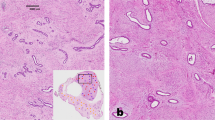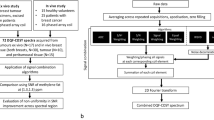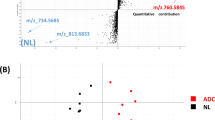Abstract
Phospholipids from malignant, benign and noninvolved human breast tissues were extracted by chloroform-methanol (2:1) and analysed by 31P MR spectroscopy at 202.4 MHz. Thirteen phospholipids were identified as constituents of the profiles obtained among the 55 tissue specimens analysed. Observed patterns in phospholipid tissues profiles were distinct, allowing qualitative characterisation of the three tissue groups. Multivariate analysis of lysophosphatidylcholine (LPC) and an uncharacterised phospholipid were shown to be independently significant in predicting benign tissue histology as either fibrocystic disease or fibroadenoma in 92% of cases. Univariate analysis of relative mole-percentage of phosphorus concentrations of individual phospholipids using the Scheffé comparison procedure revealed that in malignant tissues, phosphatidylethanolamine was significantly elevated compared to benign (+ 32%) and noninvolved tissues (+ 22%). Phosphatidylinositol (+ 33%) and phosphatidylcholine plasmalogen (PC plas) (+ 25%) were increased in malignant compared to benign and LPC was decreased (-44%) in malignant compared to noninvolved. LPC was significantly depressed (-39%) in benign tissue compared to normal. Phospholipid indices computed to further characterise the three tissue groups showed PC plas/PC elevated in malignant tissue compared to benign and PE plas/PE depressed in malignant tissue compared to noninvolved. These findings support previous investigations reporting that the alkyl-phospholipid analogues of phosphatidylcholine are released by malignant tissues and that levels of ethanolamine are elevated in malignant tissues. Indices describing the choline-containing phospholipids showed that these lipids are depressed significantly in malignant tissue relative to healthy tissue.
This is a preview of subscription content, access via your institution
Access options
Subscribe to this journal
Receive 24 print issues and online access
$259.00 per year
only $10.79 per issue
Buy this article
- Purchase on Springer Link
- Instant access to full article PDF
Prices may be subject to local taxes which are calculated during checkout
Similar content being viewed by others
Author information
Authors and Affiliations
Rights and permissions
About this article
Cite this article
Merchant, T., Meneses, P., Gierke, L. et al. 31P Magnetic resonance phospholipid profiles of neoplastic human breast tissues. Br J Cancer 63, 693–698 (1991). https://doi.org/10.1038/bjc.1991.157
Issue Date:
DOI: https://doi.org/10.1038/bjc.1991.157
This article is cited by
-
Drug resistance in cancer: mechanisms and tackling strategies
Pharmacological Reports (2020)
-
Comprehensive quantitative lipidomic approach to investigate serum phospholipid alterations in breast cancer
Metabolomics (2017)
-
Determination of lipidomic differences between human breast cancer and surrounding normal tissues using HILIC-HPLC/ESI-MS and multivariate data analysis
Analytical and Bioanalytical Chemistry (2015)
-
Lipidomic approach to identify patterns in phospholipid profiles and define class differences in mammary epithelial and breast cancer cells
Breast Cancer Research and Treatment (2012)
-
Effect of radiotherapy and chemotherapy on composition of tumor membrane phospholipids
Lipids (1997)



